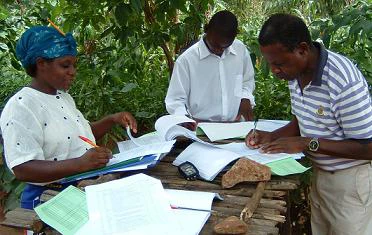
There are, in sub-Saharan Africa, more household surveys with asset information than information on income or consumption. To some extent this will always be the case as most surveys that collect income or consumption data also collect asset information while the reverse is not true. But more importantly, many surveys collect only asset information given the cost (and complexity) of collecting a monetary measure of welfare. The original asset index is probably the unmet basic needs indicators formed from census data in the 1960s and 1970s. In the absence of good household surveys, these were helpful indicators to understand, a bit, how people lived. Then the era of household surveys rolled in and suddenly we were able to pick apart the poverty story, understand how poor some people really were and make clear comparisons across groups and across time. This is what we want, but we can’t always get it due to the costs. So, in recent years, the asset index has been put forth as a proxy for income or consumption. Better than nothing, it is argued and, in some cases, valuable in its own right. The problem with an asset index is that it is hard to use. Construction is easy. As Deon Filmer and I show in a forthcoming paper in Demography, it doesn’t appear that it matters tremendously how you add up your radios and beds. But the index only ranks households; it doesn’t tell you much about the distance between households and inequality in any way that one can really talk about. (Think for example, is having two beds better than two radios? Or is one bed, a radio and a wood floor better then two beds and a dirt floor?). Money makes life easier, both to spend and to measure welfare and talk about inequality.
Having said that, Deon and I do find that the asset index works for some purposes: inferences about the importance of economic status in education, health and some labor outcomes are quite robust to the choice of per capita consumption or an asset index. But, consumption measures and asset indices are different measures: the rank correlation coefficient between per capita consumption and various asset indices averaged around .55 to .60 for the eight countries we looked at. So, while asset indices have their role, they are not a substitute for a good monetary measure of welfare.
Back to the overall household data picture. There is good news and bad news. The good news is the increase in the number of national household surveys in the world, not least in Sub-Saharan Africa, that provide monetary measures of welfare and asset data. In 1979 Robert McNamara, then President of the World Bank, was supposedly shocked to see so many holes in the first World Development Report--- only 17 developing countries had micro, distributional data, yet macroeconomic variables were available for almost all. The need to rectify this situation was the impetus for the LSMS. The first LSMS surveys were done in 1985 in Peru and Côte d’Ivoire, the most recent are in the field as we speak, but I’ll come back to that. The advantage of LSMS, and other multi-topic, household surveys is that one can look at the causes and correlates of observed outcomes, and not be stuck just knowing that malnutrition is 12 percent without having a clue why that is so or the most efficient way to lower it.
The bad news on the data front is that there are not enough countries that systematically collect comparable national data on anything, let alone poverty. ( Ethiopia, Ghana and South Africa stand out as exceptions) But more is needed to give rise to a culture of empirically-based policy making and create sustainable survey programs. It is not only about money --even DHS surveys which are typically more expensive than the LSMS surveys get done with some regularity—but instead a series of complex factors that will have to be the subject of another post.
For those of us who want more data and better data in Sub-Saharan Africa, there is further good news. The Bill and Melinda Gates Foundation have provided funding to the LSMS for a new initiative: the LSMS-Integrated Surveys on Agriculture or LSMS-ISA. Six countries are benefiting from this initiative as we collaborate closely with national data producers and users, particularly ministries of agriculture, to develop and implement panel LSMS surveys with a substantial agricultural module. The data sets will advance research and policy work on agriculture’s role in welfare and household activities. And need I go on about the fun of having that much panel data to work with? We have also built in rigorous validation of new techniques and methods to keep expanding knowledge of what works in data collection and what doesn’t. All of this data will be publicly available within a year of collection. The first data set is already available for Tanzania; Malawi, Nigeria and Uganda are soon to follow. Ethiopia and Niger will be in the field this year. The model is already being built on: USAID is now funding the inclusion of a seventh country—Mali-- in the project.
So not all is completely bleak, good monetary measures of welfare will be available for another group of countries over the next few years in Africa. But, as in the rest of the world, further coordination and clever ideas on how to move us all closer to the goal of sustainable systems of data collection are still needed.


Join the Conversation